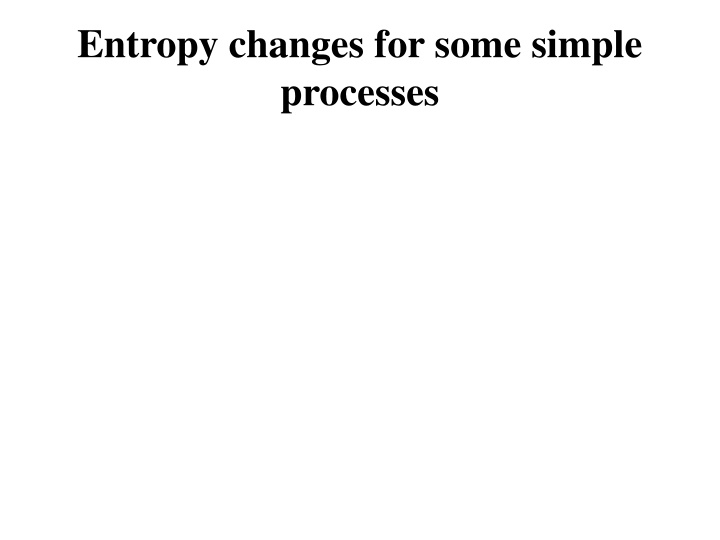
Entropy Changes in Simple Processes
Explore the concept of entropy changes in various simple processes such as phase changes, reversible isothermal volume change, irreversible isothermal volume change, and more in thermodynamics. Learn about the spontaneous nature of gas expansion, mixing of gaseous samples, and the relationship between entropy and state functions.
Download Presentation

Please find below an Image/Link to download the presentation.
The content on the website is provided AS IS for your information and personal use only. It may not be sold, licensed, or shared on other websites without obtaining consent from the author. If you encounter any issues during the download, it is possible that the publisher has removed the file from their server.
You are allowed to download the files provided on this website for personal or commercial use, subject to the condition that they are used lawfully. All files are the property of their respective owners.
The content on the website is provided AS IS for your information and personal use only. It may not be sold, licensed, or shared on other websites without obtaining consent from the author.
E N D
Presentation Transcript
Entropy changes for some simple processes
Solid Liquid, Solid Vapour, Liquid Vapour and Solid I Solid II.
Isothermal (i.e. T constant) u = 0, from first law q = W = PextdV = PdV = (nRT/V)dV = nRTln(V2/V1) = qrev.
But S = qrev/T = (nRT/T)ln(V2/V1) = nRln(V2/V1).
Note that for expansion V2> V1and S is positive. Thus the expansion of a gas to fill all available space is spontaneous.
S is a state function independent of path, hence S is the same as for reversible path between the two states, S = nRln(V2/V1).
Mixing of two gaseous samples (even if both are at constant T & P).
S = n1Rln[(V1 + V2)/V1] + n2Rln[(V1 + V2)/V2]
Therefore, even if V1= V2, S must increase i.e. mixing is a spontaneous process.
Reversible Adiabatic & Irreversible Adiabatic change dqrev = 0, therefore S = 0.
Entropy change on heating or cooling a substance at constant volume process
CpdT/T. The investigation of this expression depends on whether Cv& Cpare temperature dependent or are completely constant and independent of temperature in the range considered.
Simultaneous heating and expansion of a gas initial T1V1and final T2V2, this can be seen as 2 reversible steps, qrev= u + W and qrev= CvdT + PdV.
Step 1: Heat at constant volume V1 from T1to T2, S1= (T1< x < T2) CvdT/T.
Step 2: Expand gas Isothermally at T2 from V1to V2,
S2= (V1< x < V2) RdV/V = (V1< x < V2) (1/T) (RT/V)dV
Therefore, Stotal= S1+ S2= (T1< x < T2) (Cv/T) dT + (V1< x < V2) (R/V) dV
= (T1< x < T2) (Cv/T) dT + Rln(V2/V1).
Similarly, Stotal= (T1< x < T2) (Cv/T) dT - Rln(P2/P1)
For a process occurring at constant volume S = Cvln(T2/T1)
Application of 2ndlaw to some simple types of chemical reaction
accompanying 1 mole of A 1 mole of B be S. If x mole of A has reacted, then entropy change of reaction is x S. Entropy change of both is -x H/T, where H is the enthalpy change accompanying the transformation of 1 mole of A 1 mole of B. Therefore, S(total for isolated system or universe)= x S - x H/T = x( S - H/T) = -x/T( H T S).
Stotal= -x/T[(H2 H1) T(S2 S1)] = -x/T[(H2 TS2) (H1 TS1)]
Since H, S and T are properties of the state of system, the quantity H - T S is also a state property which is denoted by G that is the Gibbs free energy.
x/T(G2 G1) = -x/T(G). For the process to be spontaneous in this isolated the system S > 0 i.e. +ve since x is the number, than G must be negative.
Stotal= 0 then the system must be in thermodynamic equilibrium. If G is +ve, then Stotalis ve, then the change under consideration cannot be spontaneous i.e. it will not occur naturally.
Hence entropy increases with volume increases or with temperature increases. For example melting i.e. change from solid to liquid usually involves little entropy increase, whereas evaporation i.e. change from liquid to gas involves high entropy change.
heated to 14 C. Calculate the entropy change when the process takes place at constant pressure. Take the heat capacity of Nitrogen in the relevant temperature range to be given by
Cp= 26.98 + 5.90 x 10-3T 3.40 x 10-7T2Jmol-1k-1. Answer = 5.473Jk- 1.
(H) for 1 mole of ammonia gas at 120oC. You are given that the std heat of formation for ammonia Hof (NH3) = 46.18kJmol-1.
CO2= 393.4kJmol , CO = 110.5kJmol-1, O2= -121.5kJmol- 1k-1. Std entropy of formation CO2 = 213.6Jmol-1k-1, CO = 197.9Jmol- 1k-1and O2= 205.0Jmol-1k-1. Calculate the free energy change for this reaction at 25oC and 1 atm.
atm to 500k. You may assume the normal freezing point and boiling point of water to be 273k and 373k. Latent heat of vaporization is 40.28kJmol-1, latent heat fusion is 6.00kJmol-1, molar heat capacities in units of Jmol-1k-1
Solid, Cp= 2.092 + 0.125T, liquid, Cp= 75.29 and Vapour, Cp= 30.315 + 9.621 x 10-3T + 1.184 x 10-6T2.
H2O(solid at 100k, 1 atm) H2O(solid 273k, 1 atm) H2O(liquid 273k, 1 atm) H2O(liquid 373k, 1 atm) H2O(vap 373k, 1 atm) H2O(vap 500k, 1 atm).
(100 < x < 273) [(2.092 + 0.125T)/T]dT = (2.092/T + 0.125)dT = 2.092ln(273/100) + 0.125(273 100) = 23.726.
S = Hfussion/Tfussion= (6.003 x 103)/273 = 21.989.
S = (100 < x < 273) Cp(dT/T) = (273 < x < 373) (75.3/T)dT = 75.3ln(373/273) = 23.486
S = Hvap/Tvap= (40.282 x 103)/373 = 107.99
S = (373 < x < 500) Cp(dT/T) = (373 < x < 500) [(30.315 + 9.621 x 10-3T + 1.184 x 10-6T2)/T]dT
S = (373 < x < 500) [(30.35/T) + 9.621 x 10-3+ 1.184 x 10-6T]dT
